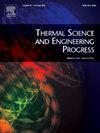Study of paraffin melt transformation properties and paraffin-based energy storage fillers
IF 5.4
3区 工程技术
Q2 ENERGY & FUELS
引用次数: 0
Abstract
To address the challenges posed by future deep geothermal disasters and further consolidate the theoretical foundation of paraffin application, this study proposes an innovative paraffin phase transition point function model. The phase transition mechanism is further elucidated through crystal dynamics. Additionally, we prepared an energy storage filling body (ESFB) and analyzed the relationship between the particle size of the phase change material (PCM) and the number of weak surfaces. Key results demonstrate: 1) With the addition of inorganic material CaCl2·6H2O, the phase transition point of paraffin decreases in the form of a function. Based on the analysis of crystal dynamics principle, the interface energy of paraffin is reduced due to the composite of inorganic material, which causes the change of phase transition point. 2) Under the same conditions, the addition of PCM has a more significant effect on the thermal conductivity than its particle size. 3) The weak interface between PCM and backfill is the key factor leading to the strength deterioration of ESFB. When the particle size of PCM is 3 mm, the deterioration effect of PCM content on the strength of the energy storage filling body is significantly weakened, and the thermal conductivity of ESFB reaches the best state. 4) The temperature rise rate of ESFB can be delayed by up to 75.17 % compared with the standard filling body.

石蜡熔体相变性能及石蜡基储能填料研究
为应对未来深部地热灾害带来的挑战,进一步夯实石蜡应用的理论基础,本研究提出了一种创新的石蜡相变点函数模型。通过晶体动力学进一步阐明了相变机理。此外,我们制备了储能填充体(ESFB),并分析了相变材料(PCM)的粒径与弱表面数的关系。主要结果表明:1)无机材料CaCl2·6H2O的加入使石蜡的相变点呈函数式降低;基于晶体动力学原理分析,石蜡的界面能由于无机材料的复合而降低,从而引起相变点的改变。2)在相同条件下,PCM的添加量对导热系数的影响比其粒径的影响更显著。③PCM与充填体之间的弱界面是导致ESFB强度劣化的关键因素。当PCM粒径为3 mm时,PCM含量对储能充填体强度的劣化效应明显减弱,ESFB导热性能达到最佳状态。4)与标准充填体相比,ESFB的温升速率可延迟75.17%。
本文章由计算机程序翻译,如有差异,请以英文原文为准。
求助全文
约1分钟内获得全文
求助全文
来源期刊

Thermal Science and Engineering Progress
Chemical Engineering-Fluid Flow and Transfer Processes
CiteScore
7.20
自引率
10.40%
发文量
327
审稿时长
41 days
期刊介绍:
Thermal Science and Engineering Progress (TSEP) publishes original, high-quality research articles that span activities ranging from fundamental scientific research and discussion of the more controversial thermodynamic theories, to developments in thermal engineering that are in many instances examples of the way scientists and engineers are addressing the challenges facing a growing population – smart cities and global warming – maximising thermodynamic efficiencies and minimising all heat losses. It is intended that these will be of current relevance and interest to industry, academia and other practitioners. It is evident that many specialised journals in thermal and, to some extent, in fluid disciplines tend to focus on topics that can be classified as fundamental in nature, or are ‘applied’ and near-market. Thermal Science and Engineering Progress will bridge the gap between these two areas, allowing authors to make an easy choice, should they or a journal editor feel that their papers are ‘out of scope’ when considering other journals. The range of topics covered by Thermal Science and Engineering Progress addresses the rapid rate of development being made in thermal transfer processes as they affect traditional fields, and important growth in the topical research areas of aerospace, thermal biological and medical systems, electronics and nano-technologies, renewable energy systems, food production (including agriculture), and the need to minimise man-made thermal impacts on climate change. Review articles on appropriate topics for TSEP are encouraged, although until TSEP is fully established, these will be limited in number. Before submitting such articles, please contact one of the Editors, or a member of the Editorial Advisory Board with an outline of your proposal and your expertise in the area of your review.
 求助内容:
求助内容: 应助结果提醒方式:
应助结果提醒方式:


